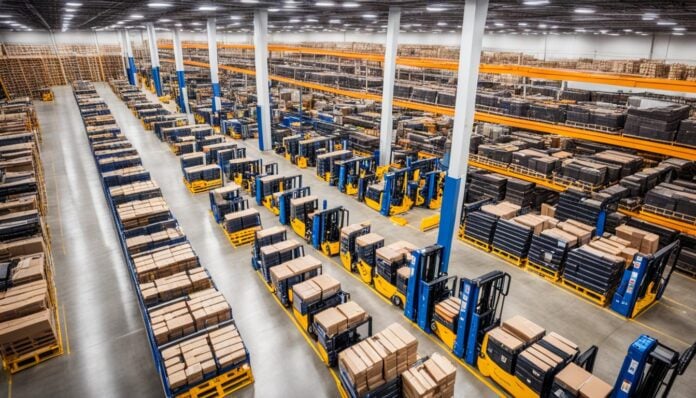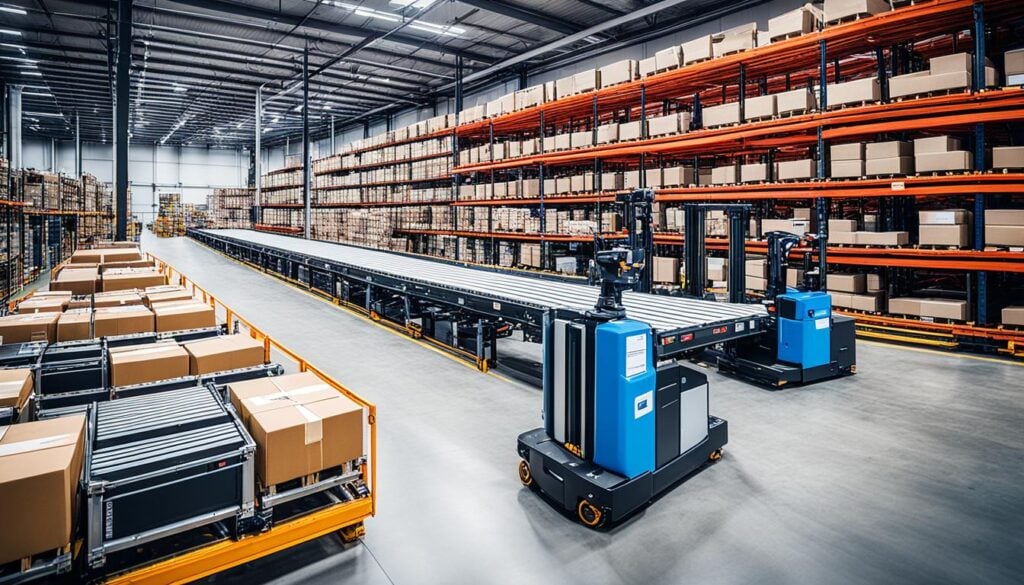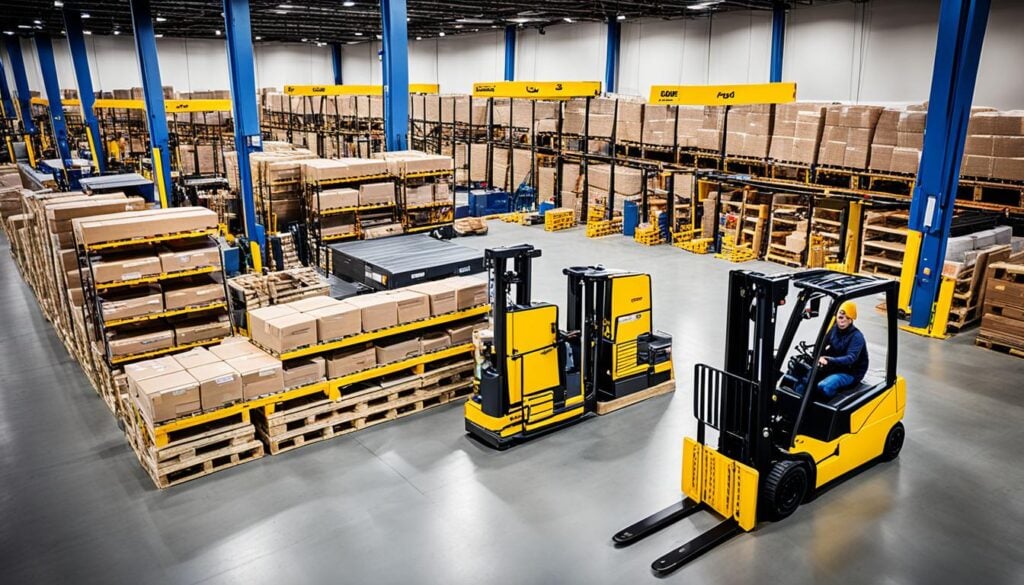In today’s fast-paced logistics industry, efficient material handling is a key factor in optimizing warehouse operations, ensuring worker safety, and maintaining the integrity of goods. Whether you’re involved in warehouse inventory management, logistics, or warehouse layout design, understanding the fundamentals of material handling is essential.
Effective material handling reduces errors, delays, and potential theft or damage to goods. It involves the movement, storage, protection, and control of materials and products throughout the supply chain ecosystem. From storage and handling equipment to engineered systems and industrial trucks, the right combination of material handling equipment and strategies can significantly impact your warehouse’s performance.
In this guide, we’ll explore the key components of warehouse material handling, strategies for maximizing warehouse capacity, the importance of warehouse layout design, best practices for manual material handling and safety, and optimizing material handling for e-commerce fulfillment. Whether you’re a warehouse manager, logistics professional, or involved in supply chain management, this guide will provide valuable insights to enhance your material handling processes.
Stay tuned as we dive into each section to equip you with the knowledge and strategies necessary to excel in warehouse material handling.
Defining Warehouse Material Handling and Its Importance in the Logistics and Supply Chain Ecosystem
Warehouse material handling is a critical process that involves the movement, protection, storage, and control of materials and products throughout the supply chain. It serves as the foundation of efficient supply chain management, impacting various stages including manufacturing, warehousing, distribution, consumption, and disposal.
Material handling plays a crucial role in improving productivity and safeguarding goods. By implementing effective material handling practices, warehouses can ensure the smooth flow of operations, optimize warehouse efficiency, and promote worker safety. This process encompasses both manual and automated handling methods, each with its own benefits and considerations.
Manual material handling involves physical movements and poses safety risks to warehouse staff. It includes tasks such as lifting, carrying, and emptying, which can lead to injuries if proper techniques are not followed. On the other hand, automated material handling offers improved efficiency and reduces the need for manual labor. Through the use of advanced equipment and systems, automation minimizes the risk of errors and enhances productivity.
In addition to enhancing warehouse operations, material handling also contributes to effective inventory management. By keeping materials and products organized and accessible, inventory accuracy and visibility are improved, reducing the risk of stockouts or overstocking. This, in turn, helps to streamline supply chain processes and ensures timely order fulfillment.
Considering the critical role of material handling in warehouse and supply chain management, it is vital for businesses to prioritize this aspect of their operations. By investing in appropriate equipment, training employees on safe handling techniques, and implementing efficient systems and processes, warehouses can optimize material handling and achieve enhanced productivity, efficiency, and customer satisfaction.
Key Components of Warehouse Material Handling
Warehouse material handling involves various components that work together to optimize the movement and storage of goods. Understanding these key components is crucial for achieving efficient warehouse operations. Let’s explore the essential elements of warehouse material handling:
Storage and Handling Equipment
Storage and handling equipment play a vital role in warehouse operations. Racks, shelves, and bins provide effective storage solutions for organizing and containing goods. These components ensure easy accessibility and efficient space utilization, enabling quick retrieval and replenishment of items.
Engineered Systems
Engineered systems, such as automated storage and retrieval systems (AS/RS) and conveyor systems, streamline the movement of goods within a warehouse. AS/RS efficiently handles inventory management and retrieval, while conveyor systems facilitate the smooth flow of items from one area to another. These systems minimize manual handling and contribute to increased productivity and accuracy.
Industrial Trucks
Industrial trucks, including forklifts, hand trucks, and pallet jacks, are indispensable for material movement in warehouses. Forklifts are commonly used to transport heavy loads over short distances, while hand trucks and pallet jacks are ideal for maneuvering smaller items. Industrial trucks enhance efficiency by reducing manual labor and expediting the handling process.
Bulk Material Handling Equipment
Bulk material handling equipment is designed to handle large quantities of goods efficiently. Stackers and silos are commonly used to handle bulk items, such as grains, liquids, or powders. By automating the movement of bulk materials, warehouses can streamline operations and optimize storage capacity.
To visualize the key components of warehouse material handling, refer to the image below:
Each component plays a specific role in optimizing material handling processes based on the unique requirements of the warehouse. By integrating these components effectively, warehouses can enhance productivity, maximize space utilization, and ensure a smooth flow of goods throughout the facility.
Strategies for Maximizing Warehouse Capacity Through Effective Material Handling
To maximize warehouse capacity, it is crucial to implement strategic material handling strategies. A well-designed warehouse layout that considers flow, accessibility, and space utilization can significantly enhance capacity and efficiency. By optimizing the placement of storage and handling equipment, implementing engineered systems, and making wise choices when it comes to industrial trucks and other equipment, warehouses can effectively streamline their operations and make the most of the available space.
When it comes to warehouse layout design, it is essential to prioritize flow and accessibility. A well-designed layout ensures that goods can be easily moved from one location to another, minimizing time wasted and maximizing efficiency. It is also important to consider space utilization and make efficient use of both vertical and horizontal storage space. By making strategic choices in warehouse layout design, warehouses can optimize their capacity and increase their overall productivity.
Another crucial aspect of maximizing warehouse capacity is selecting the right material handling equipment. Different warehouses have different requirements, and choosing the appropriate equipment can make a significant difference. Storage and handling equipment, such as racks and shelves, should be utilized effectively to maximize storage capacity. Engineered systems, such as automated storage and retrieval systems and conveyor systems, can improve operational efficiency by seamlessly moving goods within the warehouse. Industrial trucks, such as forklifts and pallet jacks, play a vital role in material movement and should be chosen based on the specific needs of the warehouse. Making informed equipment choices can greatly enhance warehouse capacity.
In summary, maximizing warehouse capacity through effective material handling involves strategic warehouse layout design and the right choice of equipment. By optimizing flow, accessibility, and space utilization, warehouses can make the most of their available space. Additionally, selecting the appropriate material handling equipment based on warehouse requirements further enhances capacity and efficiency. By implementing these strategies, warehouses can effectively maximize their capacity and improve their overall operational performance.
Navigating Types of Material Handling Equipment: Manual and Automatic
When it comes to material handling in warehouses, there are two main types of equipment that play a crucial role: manual and automatic. Understanding the differences between these types can help you make informed decisions in optimizing your warehouse operations.
Manual Material Handling: Manual material handling involves the use of hands to transport objects, perform tasks such as filling, lifting, carrying, and emptying. While manual handling is cost-effective and versatile, it poses safety risks to workers. Improper lifting techniques or handling heavy loads can lead to musculoskeletal injuries and other health issues.
Automatic Material Handling: Automatic material handling, on the other hand, utilizes automated machinery to reduce the reliance on manual movements. These automated systems can streamline processes and enhance efficiency. Automated material handling equipment can include conveyor systems, automated guided vehicles (AGVs), robotic systems, and more. While there may still be a need for employee intervention in loading and unloading, fully automated systems are currently more expensive options for most warehouses.
Both manual and automatic material handling equipment have their roles to play in warehouses. The choice between the two depends on the specific needs of your operations, budget constraints, and the level of automation you aim to achieve.
By evaluating your requirements and considering the pros and cons of manual and automatic material handling, you can make informed decisions that align with your warehouse’s goals and optimize overall efficiency.
Optimizing Material Handling for E-commerce Fulfillment
E-commerce operations pose unique challenges in material handling, requiring specific solutions to ensure efficient order fulfillment. With a high volume of orders and the need for fast processing, optimizing material handling becomes crucial in meeting customer expectations and ensuring operational efficiency.
To optimize material handling in e-commerce fulfillment, several strategies can be implemented:
- Efficient Order Picking: Implementing streamlined order picking processes can significantly improve material handling efficiency. By organizing products effectively and utilizing technology like barcode scanners, warehouse workers can quickly locate and pick items, reducing order fulfillment time.
- Warehouse Management Systems: Integrating warehouse management systems (WMS) can provide real-time inventory visibility, enabling accurate order management and efficient material handling. WMS allows for seamless coordination of storage, order processing, and shipping, ensuring smooth e-commerce fulfillment operations.
- Packaging Optimization: Optimal packaging plays a crucial role in material handling efficiency. By selecting appropriate packaging sizes and shapes, the space within storage and transportation containers can be maximized, reducing the need for excessive handling and minimizing the risk of damage during transit.
- Dimensional Weight Calculations: E-commerce businesses often ship products of various sizes and weights. Implementing dimensional weight calculations helps determine accurate shipping costs based on the package’s size rather than just its weight. This optimization strategy ensures optimal use of transport capacity and reduces shipping costs.
Implementing these solutions can help e-commerce businesses overcome the challenges they face in material handling, improving order fulfillment speed, accuracy, and customer satisfaction.
The Impact of Warehouse Layout on Material Handling Efficiency
When it comes to material handling in warehouses, the layout plays a crucial role in determining efficiency. A well-designed warehouse layout not only optimizes the flow of goods but also enhances accessibility and maximizes space utilization. This ultimately leads to reduced bottlenecks, minimized motion waste, and improved worker safety.
One of the key factors to consider in warehouse layout design is the width of the aisles. Narrow aisles may restrict the movement of material handling equipment, leading to delays and inefficiencies. On the other hand, wider aisles allow for smoother navigation and easier access to stored goods.
The proper assignment of storage locations is also essential. Strategic placement of goods based on their frequency of use or size can significantly impact material handling efficiency. By storing frequently accessed items closer to the receiving or shipping areas, workers can save time and effort during the picking and packing processes.
The placement of equipment within the warehouse is another crucial aspect of layout design. Ensuring that forklifts, conveyor systems, and other material handling equipment are strategically positioned for easy access can greatly improve overall efficiency. Workers should be able to move seamlessly between different areas of the warehouse without any unnecessary detours or obstacles.
By prioritizing flow, accessibility, and space utilization in warehouse layout design, businesses can optimize their material handling processes. The result is streamlined operations, reduced handling times, and increased productivity.
Enhancing Material Handling Efficiency through Layout Design
A well-optimized warehouse layout can have a significant impact on material handling efficiency. The strategic arrangement of aisles, storage locations, and equipment placement can minimize travel distances, reduce congestion, and improve the overall flow of goods. It also enables workers to easily access items, leading to faster picking and packing times.
Additionally, an efficient warehouse layout maximizes space utilization by effectively utilizing available storage areas. This eliminates the need for additional warehouse space, ultimately resulting in cost savings for the business. It also allows for better organization and categorization of goods, leading to improved inventory management and faster order fulfillment.
Furthermore, an optimized layout promotes worker safety by minimizing the occurrence of accidents or injuries. Clear pathways, well-marked zones, and proper equipment placement reduce the chances of collisions and other accidents. This creates a safer working environment and boosts employee morale and productivity.
In conclusion, warehouse layout design has a profound impact on material handling efficiency. By strategically arranging aisles, storage locations, and equipment placement, businesses can enhance flow, accessibility, and space utilization. This ultimately leads to streamlined operations, improved worker safety, and increased productivity.
Best Practices for Manual Material Handling and Safety
Manual material handling plays a vital role in warehouse operations, even in the age of automation. To ensure the safety of your workers and minimize the risk of injuries, it is crucial to follow best practices in manual material handling.
First and foremost, providing proper training on lifting techniques is essential. By teaching employees the correct way to lift and carry heavy objects, you can significantly reduce the chances of strain or sprain injuries. Encourage the use of ergonomic tools and equipment as well, as they are designed to minimize physical exertion and support the body’s natural movements.
In addition to training and ergonomic tools, implementing strict safety protocols is crucial. Create clear guidelines for manual material handling tasks, such as weight limits and proper lifting postures. Regular supervision is also essential to ensure compliance and address any issues or concerns that may arise. By prioritizing safety and maintaining a culture of training and supervision, you can mitigate the risks associated with manual material handling and promote a safe working environment for your warehouse staff.

































